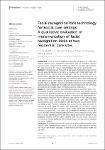Facial recognition lock technology for social care settings: A qualitative evaluation of implementation of facial recognition locks at two residential care sites
| dc.contributor.author | Bradwell, Hannah | |
| dc.contributor.author | Edwards, KJ | |
| dc.contributor.author | Baines, R | |
| dc.contributor.author | Page, T | |
| dc.contributor.author | Chatterjee, Arunangsu | |
| dc.contributor.author | Jones, Ray | |
| dc.date.accessioned | 2023-04-17T13:39:20Z | |
| dc.date.available | 2023-04-17T13:39:20Z | |
| dc.date.issued | 2023-03-03 | |
| dc.identifier.issn | 2673-253X | |
| dc.identifier.issn | 2673-253X | |
| dc.identifier.uri | https://pearl.plymouth.ac.uk/handle/10026.1/20719 | |
| dc.description.abstract |
Background: There is limited literature on security and access for social care settings despite policy highlighting importance, and no published research exploring facial recognition lock technology (FRLT) for potential improvements. This study explored FRLT device implementation, use, barriers and benefits. Methods: One residential care home with 43 older adults and 68 staff members (Site A), and one supported living facility caring for six individuals with mental health issues with 18 staff members (Site B) were provided with FRLT for six months. Nine pre-implementation staff interviews explored existing access and security perceptions. Ten post-implementation staff interviews and one staff focus group were conducted; all were analysed using content analysis to understand, alongside process mapping, the use and impact of the FRLT. Interview participants included site care staff and other visiting healthcare professionals. We additionally report feedback from the technology developers to demonstrate impact of industry-academia collaboration. Results: Pre-implementation interviews highlighted issues with current pin-pad or lock-box systems, including; code sharing; code visibility, ineffective code changes, security issues following high staff turnover, lack of efficiency for visitors including NHS staff and lack of infection control suggesting requirement for innovation and improvement. Pre-implementation interviews showed openness and interest in FRLT, although initial queries were raised around cost effectiveness and staff skills. Following implementation, good levels of adoption were achieved with 72% and 100% (49/68 and 18/18) of staff members uploading their face at the two sites, and 100% of residents at Site B using the system (6/6). Additionally, Site B made a positive procurement decision and continues to discuss wider rollout. Post implementation interviews suggested FRLT was useful and acceptable for improving security and access. Benefits identified included staff/visitor time saving, enhanced security, team ease of access, resident autonomy and fewer shared touch points. Integration was suggested including with fire alarm systems, staff clocking in/out, and Covid monitoring to improve usefulness. The developers have since responded to feedback with design iterations. Conclusion: We identified concerns on security and access in social care settings, which warrant further exploration and research. FRLT could increase resident autonomy and reduce staff burden, particularly considering frequent multi-agency health and care visits. | |
| dc.format.extent | 1066327- | |
| dc.format.medium | Electronic-eCollection | |
| dc.language | eng | |
| dc.publisher | Frontiers Media SA | |
| dc.subject | access | |
| dc.subject | care home | |
| dc.subject | facial recognition | |
| dc.subject | facial recognition technology | |
| dc.subject | innovation | |
| dc.subject | safety | |
| dc.subject | security | |
| dc.subject | social care | |
| dc.title | Facial recognition lock technology for social care settings: A qualitative evaluation of implementation of facial recognition locks at two residential care sites | |
| dc.type | journal-article | |
| dc.type | Journal Article | |
| plymouth.author-url | https://www.ncbi.nlm.nih.gov/pubmed/36937251 | |
| plymouth.volume | 5 | |
| plymouth.publication-status | Published online | |
| plymouth.journal | Frontiers in Digital Health | |
| dc.identifier.doi | 10.3389/fdgth.2023.1066327 | |
| plymouth.organisational-group | |Plymouth | |
| plymouth.organisational-group | |Plymouth|Research Groups | |
| plymouth.organisational-group | |Plymouth|Faculty of Health | |
| plymouth.organisational-group | |Plymouth|Faculty of Health|School of Nursing and Midwifery | |
| plymouth.organisational-group | |Plymouth|Research Groups|Institute of Health and Community | |
| plymouth.organisational-group | |Plymouth|REF 2021 Researchers by UoA | |
| plymouth.organisational-group | |Plymouth|Users by role | |
| plymouth.organisational-group | |Plymouth|Users by role|Academics | |
| plymouth.organisational-group | |Plymouth|REF 2021 Researchers by UoA|UoA03 Allied Health Professions, Dentistry, Nursing and Pharmacy | |
| dc.publisher.place | Switzerland | |
| dcterms.dateAccepted | 2023-01-26 | |
| dc.date.updated | 2023-04-17T13:39:19Z | |
| dc.rights.embargodate | 2023-4-18 | |
| dc.identifier.eissn | 2673-253X | |
| dc.rights.embargoperiod | forever | |
| rioxxterms.versionofrecord | 10.3389/fdgth.2023.1066327 |


